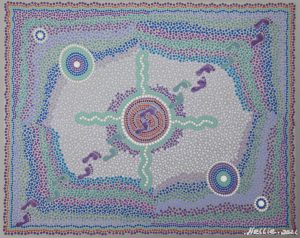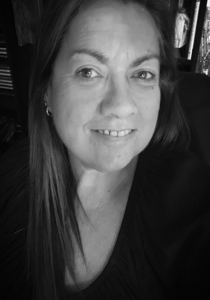The process of decolonising spaces
The mechanisms decolonising this space are cultural. We cannot communicate with direct speech, play music, nor can we gesture, but through language and art, this place can demonstrate decolonising spaces’ powerful impacts on health, social connection, wellbeing and self-expression. This process of decolonising spaces, including physical environments such as healthcare settings, can be replicated in principle and process by podiatrists, and the businesses and organisations within which we work, to promote positive healthcare experiences for First Nations Peoples.
A name change for this space in STRIDE
The first change to this space is the name, Gugurr yan.guwan dhadhadya (pronounced gu-gurr yan-gwa da-da-ja), which translates to ‘Keep on walking strong;’ demonstrating inclusive and respectful language and importantly, promoting and privileging First Languages. The guardians of language and Community have always known of the positive connection between language and wellbeing in this country, and all of us should know and understand this relationship. Colonisation continues to destroy First languages use, a culturally protective health factor for Aboriginal and Torres Strait Islander Peoples, and a key representation of the diversity of sovereign First Nations.
Gugurr yan.guwan dhadhadya (‘Keep on walking strong’) by Nellie Green.
This name for this section in STRIDE comes from Badimaya Country. We acknowledge the dedication of Badimaya Elders and Community in their work to revitalise a language almost lost through violent colonising processes. See if you can locate Badimaya Country on the Australian Institute of Aboriginal and Torres Strait Islander Studies First Nations map.
If you are having trouble finding it, that is because there are so many diverse groups included on the map. They are representative of the sovereign Nations, the kinships, the languages, and the lores that make up the oldest continuing living culture on earth. Gugurr yan.guwan dhadhadya promotes this fact, bringing First Nations recognition, resilience, and pride to this space. Additionally, the term ‘Indigenous’ has gone. Although commonly used by government and in mainstream publications, this term homogenises Aboriginal and Torres Strait Islander Peoples instead of acknowledging diversity across sovereign First Nations. It dehumanises too, with links to ‘colonial research’ grouping First Nations Peoples with flora and fauna. Being government imposed, the term ‘Indigenous’ is considered inappropriate by some people across First Nations.
The second change is the inclusion of Aboriginal and Torres Strait Islander worldviews. First Nations artist Nellie Green now speaks to this space through her art of the same name, Gugurr yan.guwan dhadhadya (‘Keep on walking strong’).
Dedicated for our progressively decolonised space here in STRIDE, Nellie’s art educates us into First Nations perspectives of foot health. Nellie describes her work, sharing “the importance of foot health to First Nations Peoples, with footprints in the work depicting the footsteps that take us through a lifetime.”
Nellie continues, “Footsteps that carry us on continuous journeys along different paths, that carry the energy, that carry the burdens, that carry the accomplishments, and that carry the stories of our own lives.”
Nellie describes the colours she has used in the art. “[It is] … a means to present a serious message in good humour. While the loss of foot health is traumatic, a lot of people need to get over the stigma about feet and hiding them, and need to be proud of their feet, considering what they put up with and what we put them through.
As Nellie concludes, “We trust our feet to bring us home.”




